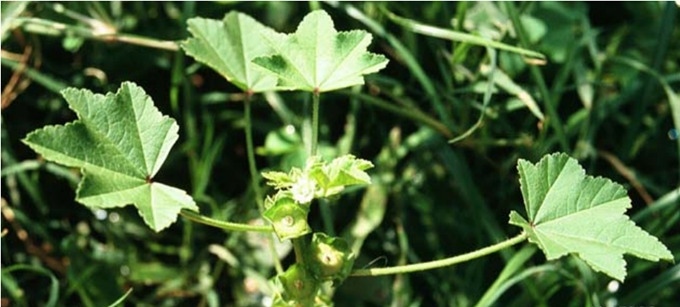
Figure 1. Mallow (courtesy HerbiGuide)
Description: Mallow (Malva parviflora) is an annual, biennial or perennial weed that can grow up to 1.5 m tall and has a single taproot. It produces small pink, mauve or white flowers throughout late autumn to late spring.
As a soil indicator: Mallow is an indicator of very low calcium and soil organic matter, high potassium, iron, aluminum, and very high magnesium. It is also an indicator of waterlogged, compacted soil with poor drainage.
Negative attributes: Mallow competes with other plants for water and nutrients, reducing wheat grain yields by up to 30%. Plant toxins in mallow may cause ‘staggers’ (falling over with tremors) in stock that graze significant quantities.
Dispersal: Mallow reproduces by seed, producing up to 5,000 seeds per plant. Seeds are usually dispersed by water or soil. Field observations indicate that sheep are important in dispersal.
Legislation: None
Non-chemical control methods: Control can be achieved by preventing seed set. Graze/mow heavily or cultivate early in the autumn to reduce establishment and in spring to reduce seed set. Plant a competitive crop in cultivated areas to help to prevent the re-establishment of mallow (Sown undervine cover crops.)
Growers’ experiences: Henschke uses sheep grazing in autumn to control mallow found along the undervine straw edge. Sheep love it and tolerate it in small quantities. Henschke has also had success using rust fungus (Puccinia malvacearum) as a biological control agent to reduce the vigour and abundance of mallow in some areas.
Resources
HerbiGuide (HerbiGuide website)
Henschke Wines: A non-chemical weed control case study from the Adelaide Hills, SA
Integrated weed management in Australian cropping systems (Grains Research and Development Corporation publication)
Contact
For further information, please contact:
AWRI helpdesk
Phone 08 8313 6600 Email helpdesk@awri.com.au

